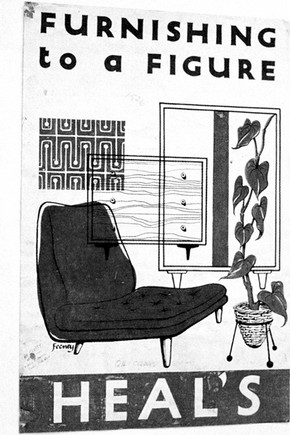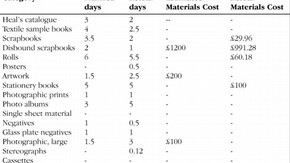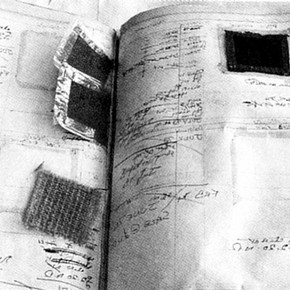Conservation Journal
January 1997 Issue 22
The Archive of Heal & Son Limited
In 1994 the second and final part of the archive of Heal & Son Limited arrived at the Archive of Art and Design at Blythe House. It joined an earlier batch of material which had been donated to the V&A in 1978. It came with enough money to employ an archivist for 14 months and a conservator for three months.
Subsequently, Jennifer Cooknell was appointed to catalogue and develop a listing structure and I was appointed to survey the archive, carry out a preservation programme and complete a report on the collection. As I was also working part-time at the Bodleian Library it was arranged that I would carry out the work two days a week over seven months, therefore my time was organised in terms of days rather than weeks. My overall work programme fell into three areas; the condition survey which took 10 days, the analysis of the survey information and report which took 12 days, leaving the remaining two thirds, or 38 days, for the actual work on the collection.

Figure 1. Heal's poster, original artwork. Photography by Helen Lindsay (click image for larger version)
The archive of a firm such as Heal's, whose existence spans the 19th and 20th centuries, inevitably includes diverse materials reflecting the history and wide ranging activities of the company (Figure 1). Although Heal's was started by two brothers in 1810 solely as a bedding manufacturer, by the 1950s it carried out contract building, textile design, restoration work and even the design of fittings and furnishings for sites such as banks, council offices, liners and restaurants. The archive details these activities in its scrapbooks, photographic albums and administration records. A significant proportion of the collection consists of photographs and negatives which record the individual furniture and artefacts sold in the store.
The formulation of a practical work plan after carrying out the survey was a crucial part of the project. The survey was based on the 1 to 4 condition ratings (where 1 is stable and 4 the most unstable) and categories of types of damage but also included information on storage and type of item. By enabling me to identify and quantify the collection it provided the basic information needed to organise a programme of work.
As mentioned earlier, the archive contains a lot of photographic material, including: 2500 glass plate negatives, 8000 large format negatives, 39 photograph albums, almost 12000 photographic prints some of which are mixed in with single sheet material, some lantern plates and slides. There are bound items varying from textile sample books and almost 100 scrapbooks, to stationery books and catalogues. Single sheet material consisted of approximately 300 posters, 5000 disbound sheets of newspaper and magazine cuttings, numerous boxes of single sheet material, 15 diplomas and 240 rolled plans and tracings.

Table 1. Comparison of the estimated work programme with the completed work programme (click image for larger version)
The information from the survey was organised into categories of material and the options for action were identified. After the categories had been ordered in terms of conservation and curatorial priority it was possible to develop a work plan (Table 1). Since the primary aim of the project was to make as much of the archive as accessible as possible, the work on the collection was spread fairly evenly, with most of the categories having something done to them. Thus the constraint of time was coupled with a work programme consisting of numerous small tasks, most of which were relatively straightforward in themselves but which required a tight hold on the use of time, facilities and materials.
Jenny had already put much of the collection into commercial folders, boxes and polyester sleeves during the listing process which meant that I was able to concentrate on areas which required greater specialist input. Even so, much of the work revolved around rehousing items, either by replacing old deteriorating storage containers or providing appropriate storage where there was none. Other main areas of work consisted of refurbishing the books, securing loose elements, cleaning and flattening items.
As Jenny and I were working on the collection concurrently we were able to discuss issues of format and order as they arose. The flattening of the rolled plans is a simple example of this. As I flattened the tightly rolled tracings and plans before they had been listed, Jenny was able to consult them after they had been put into polyester sleeves, thus reducing the potential for damage.
What looked like a commercial gum adhesive had been used extensively throughout the collection to stick photographs into albums and cuttings onto support sheets. Commonly this adhesive had discoloured and hardened. This had led to many photographs coming away from their support sheets as the leaf was turned and flexed. To stop them becoming completely detached some time was spent reattaching photographs to support sheets. Those albums whose bindings were weak or broken had phase boxes made for them. Phase boxes were also made for many of the stationery books and the textile sample books.
There was one box of glass plate negatives which had been exposed to damp or wet conditions and they were put into Silversafe four-flap folders.
Other items which were difficult to consult were a box of curled photos which were eased flat and put into polyester folders and bundles of photos in PVC sleeves.
Much of the archive was clean but items that had loose dirt deposits, such as the diplomas and mounted photographs, were cleaned and put into appropriate boxes and folders. Large single sheet items were put into polyester sleeves and negatives taken out of old strawboard boxes and put into archival boxes. The scrapbooks made with postbindings were cleaned and repaired with new brass posts and screws.

Heal's textile sample book; the samples were stuck down with pressure sensitive tape and are now detached from the support sheet. Photography by Helen Lindsey (click image for larger version)
Two categories of material were identified as being particularly vulnerable. The textile sample books in which the samples had been stuck down with pressure sensitive tape (Figure 2) and some friable poster artwork painted with gouache. These were the only items out of the whole archive for which restricted access was recommended.
The project was completed with a final report including details of all work done, materials used and materials purchased. It highlighted the items needing interventive conservation work which could not be carried out within the objectives of the present contract and listed items, such as the photographs detaching from the albums and discolouration of the scrapbook cuttings, which will continue to be at risk and which archive staff can monitor as they are used.
January 1997 Issue 22
- Editorial
- Weighing up silver objects: evaluating past and future conservation methods
- Reflections on Silver
- Investigations into the Use of Laponite as a Poulticing Material in Ceramics Conservation
- Nappies at the National Museum of Childhood
- Mounts for the Display of Books
- The Archive of Heal & Son Limited
- Slides and Frisbees - Determining Dust Deposition Rates
- Summer Placement at the Canadian Conservation Institute
- Summer Placement at the Central Research Laboratory for Objects of Art and Science, Amsterdam
- Printer Friendly Version